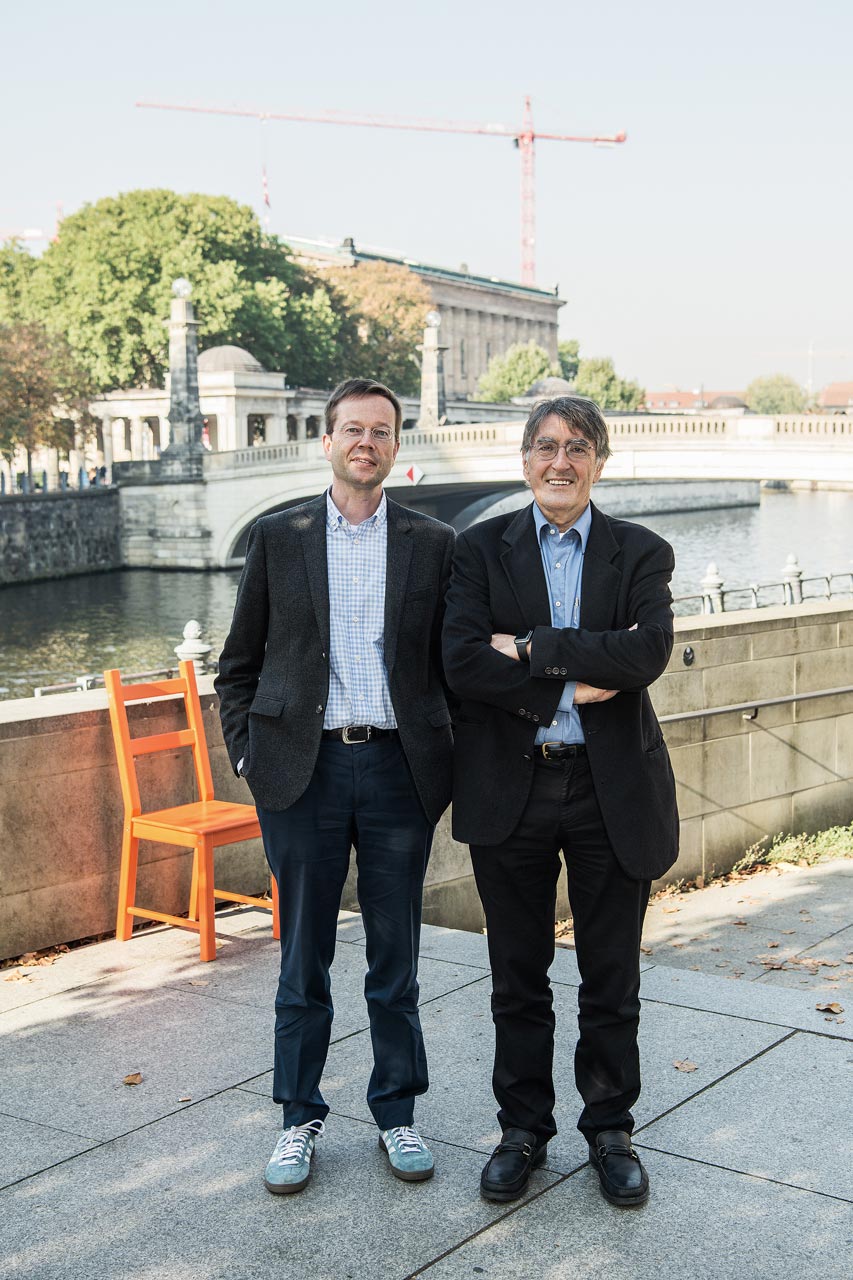The digital twin – the future of personalized medicine?
BIH Visiting Professor Hans Lehrach was already one of the brains behind the Human Genome Project. His newest idea is to develop a digital twin on which people can test important decisions concerning their health. In a joint interview with the Administrative Director of the Berlin Institute of Health (BIH), Dr. Rolf Zettl, he explained the extent to which his idea can be implemented in medicine today and what is needed to drive that development forward.
Professor Lehrach, for many years you’ve dedicated yourself to advocating for international networking in the field of personalized medicine. What motivates you to do this?
Lehrach: Actually, my motivation stems from the Human Genome Project. At that time, we were deliberating how we could use the decoded human genome to personalize medicine – assuming that technologies will become still better. That’s why, in the DigiTwins Project, we take the approach of offering a genome project – as it were – for every single patient. In computer models, we want to avoid mistakes in the choice of therapy by using digitally collected data. After all, you wouldn’t build a house that would blow down at the first gust of wind, but would instead take all the potential dangers into account using a computer. The only field in which we don’t do this is medicine. In the case of most medications, we know that they only work on a quarter of the patients. Apart from that, every year up to 200,000 people die from side-effects in Europe alone. Furthermore, not only do delays in treatment occur, but also enormous costs arise due to ineffective therapies. In our project, we argue that through better individualized prevention we could save almost half of the 4.5 billion euros that we in Europe spend on our health care system every day. In Germany, these costs are increasing markedly faster than the gross domestic product. You don’t have to be an economist to see that this isn’t sustainable in an aging society. As far as the health system goes, we’re busy rearranging the deckchairs on the Titanic instead of worrying about icebergs.
In your view, what’s the biggest challenge in driving this change in medicine forward?
Lehrach: In every other area, the development of computer models has long become established: virtual crash tests, weather forecasts, aircraft models, etc. Of course, these developments wouldn’t exist without considerable financial investment. This is something that hasn’t yet been acknowledged in medicine. There, the only innovations that are funded are those that already save costs at the time of giving the funding. In the case of solar energy, decision-makers have understood that we can only implement revolutionary developments effectively and quickly if we subsidize the process for a certain period. Had we developed solar cells in accordance with the cost covering principle of medicine, they might not have come onto the market until the beginning of the third millennium.
Do you think there may be a certain reticence because medicine involves people’s own intimate details?

Funding program
BIH Visiting Professors
Funding period
2018 – 2022
Project title
DIGITWINS: Digital Twins for Better Health
Research area
Genetics
Institution
Berlin Institute of Health (BIH)
Since 2008 (2010)
Founder and Scientific Director, Alacris Theranostics GmbH and Dahlem Centre for Genome Research and Medical Systems Biology, Berlin, Germany
Since 1994
Director (Emeritus) and Scientific Member of the Max Planck Institute for Molecular Genetics, with a scientific focus on genetics, genomics and systems biology, Berlin, Germany
1987 – 1994
Head of the Genome Analysis Department of the Imperial Cancer Research Fund, London, UK
Lehrach: I think it’s more a question of funding – especially as many stakeholders benefit hugely from the 4.5 billion euros spent on health. Naturally the stakeholders don’t want to tamper with a system that gives them a good living. Until they’re certain that a new system will benefit them financially just as much, I think that’s a much more important factor that’s slowing everything down. Seriously ill patients are primarily interested in receiving the best possible treatment: data protection seems to play a rather subordinate role among such patients. Of course, I think data protection is important too, but not at the expense of the quality of medical treatment...
Why is the digitization of medicine nevertheless advancing only slowly in Germany?
Lehrach: For a long time, the processing power of computers was a major obstacle to processing the data collected. However, every ten years it increases a thousand fold. Despite further training, it does of course take people much longer before they can actually utilize this progress. A doctor can’t know and understand all the algorithms and molecular technologies.
Is it easier to win over doctors who’ve grown up with the new technologies?
Lehrach: I think that doctors handle digitization differently if they’ve understood the developments from the start. We have areas in medicine that are already hugely personalized. In surgery, the doctor has the option of looking at the precise occurrences in a patient’s body using imaging procedures.
Conversely, a medication affects patients’ molecular networks, but the physician has no inside view of those at present. So the physician doesn’t have the ability to predict patient responses to therapy either. It’s as if someone were to break their left arm but gets a plaster cast put on their right arm because in a clinical experiment most of the patients broke their right arm and the doctor can’t differentiate between the patients.
Many researchers value the Core Facilities at the BIH, which enable them to transfer tasks that they themselves are unable to carry out to experienced experts. Dr. Zettl, what role could the BIH play in this development over the coming years?
Zettl: The BIH has expressly committed itself to personalized medicine – and that’s basically the crux of the DigiTwins Project. All the technological platforms that we create at the BIH are integrated into the DigiTwins Project. Mr. Lehrach is therefore an ideal addition to the Institute. It’s also an important project with regard to applicability and patient benefit. The aim is not to generate data in basic research, but to feed patient data into a model in order to personalize it.
This creates direct added value for the patient. I’m very happy that we’re walking this road together and that Stiftung Charité is supporting us in doing that.
Mr. Lehrach, how often do you sit down at the computer yourself?
Lehrach: I do a lot myself: data analysis, modelling… At the same time I’m trying to steer the project, which has over 200 partners, in the right direction. In between, I focus on some basic questions that we still need to clarify. The stumbling block at the moment is the fact that the computer systems need certain parameters – for example, how fast responses occur in a specific tissue. However, that information isn’t available. We can nevertheless assume some parameters as a given, based on which we generate virtual trials. In models with these trials we can finally see whether we can derive data sets that confirm the parameters originally assumed.
So these are like high-end computer games for scientists…By when do you want to have created the first digital twin?
Lehrach: Of course, it depends what question you’re seeking to answer. We’re relatively close to being able to generate realistic twins of tumors. We must, of course, augment these with other information. When a patient takes medication, their microbiome decides what happens with it. So in fact we would have to characterize their microbiome in order to predict how the medication will work. Nowadays, the field of pharmacogenetics allows you to deduce from the patient’s genome what processes will occur in the liver. So when treating a virtual patient, you can also test the side effects. Equally important would be to characterize a patient’s immune system. If you want to take the cardiovascular system into consideration too, you have to collect additional data on the physiology of the heart or the blood circulation. The digital twin must therefore be expanded pragmatically, application by application.
So is the logical conclusion that at some point every newborn will get a digital twin for making future decisions in life?
Lehrach: Actually, it should already be possible to sequence the child’s genome and to take appropriate measures before the birth.
Do parents always want to know something like that?
Lehrach: Provided it’s possible to do something, they usually want to know. It’s a different matter if it’s impossible to do anything anyway.
Mr. Zettl, was part of your aim to also show the wider public how they can benefit from health research?
Zettl: The BIH’s task is to bring innovation to the patient. As far as trailblazing Nature articles on mouse models go, there are other scientists in the city who are doing excellent research in that field. For us, a project that brings together cutting-edge technologies and top researchers from all over Europe is a transmission belt and an enabler for bringing the visions that we have here to the person in the street.
It is, however, a long process before it reaches the patient. How do you keep your ability to persevere?
Lehrach: We’re already using these concepts in treating cancer patients – though not to their full extent. Both in research projects and in a spin-off, we have patients who are being examined with the latest technologies and are definitely receiving better therapy as a result. We pursue this approach in molecular tumor pathology at the Charité.
So some patients are already benefiting from personalized medicine – but what’s the current situation for patients if they don’t get into the right clinic or live in the wrong town?
Lehrach: At the moment, patients read or hear about personalized concepts in magazines or on television and then contact us or other start-ups. Of course, as it isn’t covered by the state health insurance schemes, the concept isn’t very widespread yet. Luckily, the costs of such treatments are decreasing. There’s no question that we must try to make these offers accessible through the hospitals. We’re optimistic that we’ll be able to convince the hospitals.
So when it’s a question of which services the state health insurance schemes will pay for, does it depend on whose arguments are more persuasive?
Exactly. But we have extremely good arguments – and hopefully we’ll soon have still better opportunities to reach as many people with it as possible with this approach.
October 2018 / MM
